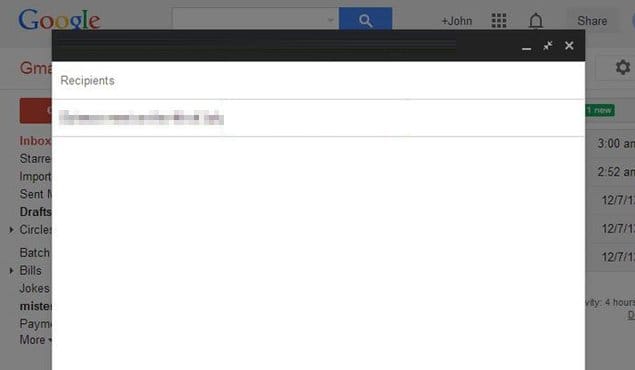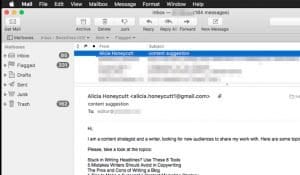One must remember that the word “perfect” is subjective, not objective. There is a perfect piece of pizza for me, and it’s likely different from the perfect slice for you, and it’s most definitely different from the perfect slice from any born and raised Chicagoan.
My point with the pizza is that writing the perfect pitch to a blog editor has one specific thing in common — it has to be perfect to them.
This is a difficult thing to do, but not impossible. Actually, trying to get as close as possible to that perfect, individualized pitch is the precise method by which you get accepted and published, which is the whole point of pitching in the first place.
There are many key factors in writing the perfect pitch, which I’ll explore below. But first…
What is a Blog Editor?
The tips I’m about to provide are specific to the blog editor. This editor is different than your typical editor in that they are dealing primarily with a blog, not with a newspaper or journal. Blogs, in the truest sense of the word, are smaller and more individualized than a large scale website.
The New Yorker, The Atlantic, and even Buzzfeed are not blogs — at least, not for this article. They are more like news organizations, too mainstream to be very applicable here.
Quick Sprout, Boing Boing, and Mashable, however, are blogs. The line is fine when drawing the distinction between what is and isn’t a blog, but I’m basically sticking to websites that have a singular focus, rather than those that cover a wide variety of topics.
The New Yorker is very political, but it also includes humor, fiction, environmental issues, etc. Quick Sprout is about internet marketing, and only internet marketing.
The difference is important because when you pitch a blog editor you are already in a niche. Therefore pitching something perfect must require you to know a great deal about that niche, operating in it fully, and writing from that perspective.
But I’m getting ahead of myself.
Writing the Perfect Pitch for a Blog Editor
The perfect pitch is only perfect when it gets you the publication and develops a lasting relationship with the editor. With this in mind, know that there are the straightforward mechanics of the pitch email itself, and the larger context of the guest post or contributing article that you’re writing.
I’m going to start with the perfect pitch by highlighting what you, as a writer, need to focus on in the big picture, and then break down the elements of the pitch in gritty detail.
As I mentioned above, the blog editor is someone who operates in a very specific niche, like internet marketing or new smartphone applications. A good blog will expand slightly beyond it’s core center; internet marketing blogs may write articles on guest posting, while smartphone application blogs will include the recent Macbook Pro announcement.
The blog has to operate within its general sphere of influence, though, or it won’t be valuable to its readers. As such, the first thing you need to do in the big picture is know what the niche of that blog is, and how you fit in.
Know Thyself and Thy Niche
The expression of this will come in the nitty gritty section, but the general premise has to be there well before you even start writing the email.
You must know the niche you are pitching in. You must be an avid reader of blogs in that niche, some sort of expert in that niche, and you must have something relatively unique to say in that niche. Otherwise legitimate websites will not take you seriously, and your pitch can’t be perfect.
The good news is that we’re in the age of information, which means you can become a near-expert sitting at home, reading. Not a full expert — that takes real life experience and time. But, as a way to break into a niche you already love and want to write in reading up online is the place to start.
Whatever your niche, make sure you have read the lengthy backlog of the blog you’re pitching. Then read any blogs they recommend. Then do a google search for your niche’s keywords — “internet marketing”, “how to market on the internet”, etc. — and read any blogs that come up.
Get to know names, styles, philosophies of your niche. All of this will make that pitch perfect.
Learn How to Write
It may sound silly, but a major background step in this whole perfect pitch process is being a decent writer. I can’t tell you the number of guest post pitches I have received that don’t use periods, commas, colons, and the dreaded semi-colon correctly. They also often have poor word choice and therefore don’t make sense.
It doesn’t matter if your terrible writing is in the email pitch or guest pot itself. A blog editor typically won’t work with someone who can’t write because it means way more time on their end, editing not just for concepts and ideas, but the execution of those ideas.
As a background step, learn how to write. The assumption here is that, since you want to write for a blog, you’re probably a pretty decent writer already. That’s great, but keep in mind that you need to write the perfect pitch. Writing is one of the harder things to do in this world, and if you want to execute perfect writing to a specific individual, you’re going to need to have a way with words on command.
Here are a few tips to get better at writing before you attempt to craft the perfect pitch:
- Write your own blog posts. This is actually a necessary part of the process to getting published, so it’s killing two birds with one writing stone. Writing your own posts is the best kind of practice you can perform. You’ll get better with each one, learn more about how to structure blog articles, and build a portfolio in the process. You’ll also want to publish the articles you write, assuming they represent your voice in your niche. If they don’t, write until they do. Then publish those on your own blog.
Part of the nitty gritty pitch process will be providing examples of your work, so you’ll need to have these examples on hand, preferably published online via your own blog. - Deconstruct the blog’s posts. This is a classic writer trick. Sometimes you hear that novelists take a favorite novel and re-write it, word for word. It may sound crazy, but it helps the brain to understand how a style is executed, and how certain elements of plot move together as you write them. You can do this for the blog you’re trying to write for. Take some of their most popular articles and write them, word for word. If that’s too weird or time consuming for you, at least break down the article into its core elements and try to create one that is similar in structure.
- Write often. Practice makes perfect, and perfect writing will eventually mean a perfect pitch. Don’t write once a week, write every day. Even if it’s just a sentence or two, a paragraph at a time.
You need to practice your writing craft and view yourself as a writer, because that’s what an editor will want to see.
Get Your Ducks in Order
Before writing that perfect pitch you’ll need a few things established, some of which I mentioned above:
- A blog with examples of your published work. Takes a blogger to know a blogger. If you cold email a pitch with no examples of your writing, it cannot be perfect.
- A good email address. Don’t email from [email protected], alright? You can, but it won’t do you any favors.
- Your unique angle on the niche. This proves you’ve worked in the field you want to write for, which is a must for any editor to see.
- Know who the editor is, and what their blog is about. Just like knowing your niche, you need to know the specific editor you are writing to or it can’t be perfect.
How to Write Your Pitch
With the big picture stuff out of the way let’s dive into the nitty gritty of this email pitch. It will consist of six main parts:
1. Subject line. The subject line may at first seem like the cherry on top of a perfect pitch, but it’s actually a core ingredient in the sundae. Remember that the subject line is presumably the first and only thing an editor will see. If you saw just a cherry, you would be like, “Cool, a cherry.”
If you saw the milk being churned into ice-cream (your favorite flavor) you would stick around, right?
Well, the subject line has to be well crafted in order to hook the editor in. To make this truly perfect you should include the general idea of the article, perhaps even a sample title, and something mysterious so you get the click.
Don’t use caps, don’t claim ridiculous things, and don’t be annoying.
According to the editor’s preference, which is sometimes posted in a blog’s guidelines, follow their instructions. If they want “guest post” in the subject line, you must have it. If they want “penis enlargement” in the subject line, you must have it. (They won’t, I’m making a point).
When it comes to perfection always follow the guidelines if they exist.
2. Introduction. After you’ve gotten them to click you will imagine them reading your words in a scroll-down fashion. First is the introduction:
“Hi [editor’s name],
My name is…”
First, use their first name. The one attached to any blog posts they’ve written, or the one listed on their editorial blog, or the one in their email address, or the one on LinkedIn and social media. You must use their name!
“Hi editor” shows you have done precisely zero research on who you’re emailing, which by definition, cannot be perfect.
After using the name move onto your own introduction. This should be brief: state your name, your profession if you have one, and why you’re pitching.
3. Relationship. Within the introduction you can attempt to include some form of relationship building. You can also do this later in the email, but I like to start off with a pleasant, “Hey! I know you and what you do, let’s be friends if we’re not already!” attitude.
To be perfect you can’t come off as a brown-noser, but you do have to establish a connection. Even if it’s the fact that you interacted with them on Twitter, or had a funny comment exchange on the blog, that’s enough to build something.
Notice that to do this you have to participate in the larger, world building items mentioned above.
4. Guest article pitch. This is the actual pitch. There’s a lot of different opinions on what the actual pitch part of the email will look like, so my best advice is to follow any instructions left by the editor.
If they have none, follow these bullets:
- Include the tentative title of your article.
- Include the specific topic of your title, and how it relates to the niche.
- Include your unique view on this topic, and how you are qualified to voice that view with authority.
- Include the fact that their blog doesn’t have much content like this or explain how your article differs from similar content.
- Include other article titles, or different directions the article could go.
This is the pitch. Don’t give them the opening lines, your views on God, or just how many new subscribers they’ll get by working with you. Provide the cold hard facts and your opinion.
5. Proof of work. After the actual pitch include why you would be a good writer. This doesn’t mean state that you would be a good writer, but show them. Show them with your published blog articles, with your other published guest posts, with your X number of years in service of the niche you’re writing about, with your social following.
Any of these are indicators that you are serious, take this writing thing seriously, and seriously want to work with the editor.
6. Sign off. After all of this, write a short sentence signing off. Be friendly, be encouraging, say you’ll check in next week to see if they’ve gotten around to the email.
Don’t demand anything, don’t assume anything, and don’t leave your cell number.
If you’re writing on a news-worthy topic you can reduce the amount of time in which you’ll check in, as it’s justified to get a response.
Pitch Perfect
The above is an overview of how to write the almost perfect pitch. However, those are guidelines, and to be truly perfect you must get on a deeper level, one that shows a true understanding of the editor you are writing to.
This, unfortunately, only comes with time. The part of the pitch in which you “know” the editor will get more true over time as you become a full member of the niche. You will interact on social media, perhaps attend similar professional events, and actually work with them, even if you haven’t written for them yet. And, of course, you’ll have much more published content on great sites, which will increase your confidence and help you become a more desireable author.
Only then, and with all the above steps carefully crafted, will your guest post pitch be truly perfect.
Need help writing a pitch? Be sure to check out our Editor Pitch Email Template Generator for ideas. It’s free to use.
 ContentPowered.com
ContentPowered.com







